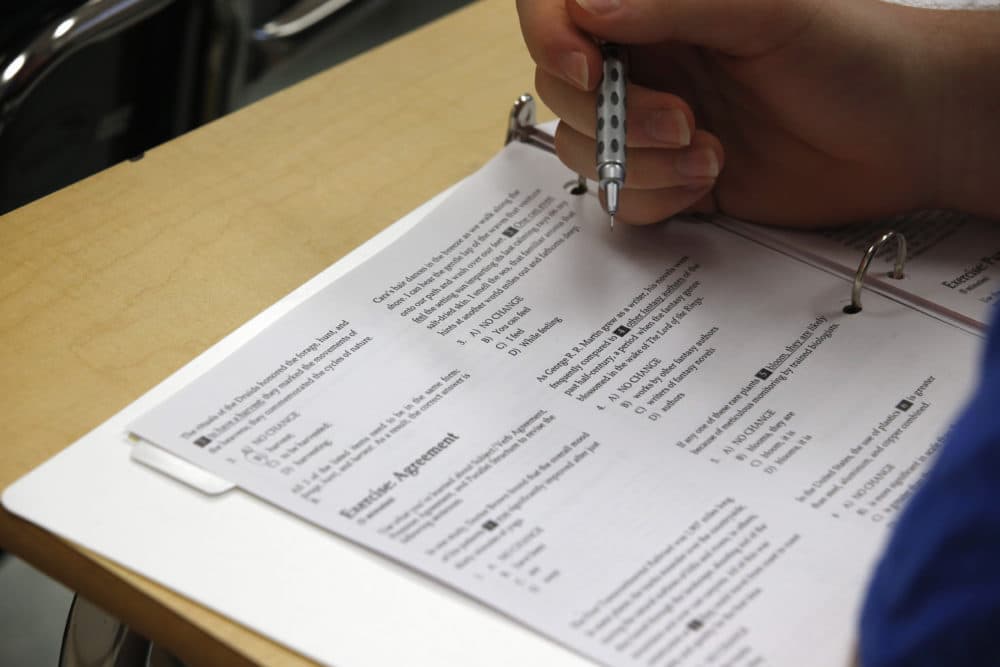Advertisement
College Board Will Reconsider Sharing SAT 'Adversity Scores' With Students

The president of the College Board, which within the last year began including a score of students' socioeconomic backgrounds on the SAT, says the nonprofit will "seriously consider" sharing the scores with students and families.
Currently, the "Environmental Context Dashboard" — or "adversity score," as it's been referred to — is only reported to college admissions officers.
"Honestly, our instincts are toward transparency," David Coleman, president and CEO of the College Board, told On Point's Meghna Chakrabarti Tuesday. "We're reconsidering it because it's confused the debate, and we prefer transparency. So we've already published how it's calculated so that's not another black box."
The College Board piloted this addition to the SAT — which weighs crime rates, poverty levels and more in students' neighborhoods and high schools — with 50 colleges last year. The beta testing will include 150 schools this fall, and then the program will expand further in 2020.
Coleman says the pilot has so far not reported scores to students because "the data isn't personal."
"It's just generally about your neighborhood and school. So it's not like students and families don't know that they go to a certain kind of school or neighborhood," he said. "But if it helps, if it is productive to share this — here's where your neighborhood ranks against other neighborhoods, here's where your school stacks against other schools — we will seriously consider sharing that if it's productive."
In his interview with On Point, Coleman also said he doesn't want to end the discussion on looking at race, which is noticeably absent from the College Board's calculations for the current version of the adversity index.
"The 'Environmental Context Dashboard' is sensitive, and that's why we're seeing concentrations of certain races at the highest level of adversity in the tool," he said. "I'm not trying to end that discussion here, but I do think it attempts to be part of a serious response, but is insufficient."
Interview Highlights
On why the College Board created this score
Coleman: "The reason why the College Board created the metric is that when you're able to see a young person's SAT scores in the context, you can see something the SAT score alone can't reveal, which is those students who are enormously resourceful, who have overcome a great deal in attaining that score. We found research by Michael Bastedo at the University of Michigan: Today, admissions officers informally do try to collect school profiles, data about the neighborhood, they visit some schools. But that information is very uneven.
"Just by making it more uniform, by creating a generalized context that all students could get similar data, the likelihood they would actually admit poor students increased by 25%. By giving this general context it gives more confidence to admissions officers. Yale was able to increase number of Pell [Grant]-eligible students by 3%. There’s a young woman in Mississippi who scored average ... if you just looked at the SAT score alone. But then if you looked at how it compared to the SAT scores in her high school, she scored 400 points higher than anyone else in her high school from a neighborhood which is rife with poverty and from a school which had very few pathways for advanced learning. All that the 'Environment Context Dashboard' did was urge a second look. In other words, a lot of this is about admissions officers’ judgment. They still read recommendation letters and essays to understand your personal life."
"Just by making it more uniform, by creating a generalized context that all students could get similar data, the likelihood they would actually admit poor students increased by 25%."
David Coleman
The College Board itself says higher adversity "is associated with only a very small increase in the risk of underperforming" based on GPA measurements.
In other words, the SAT has never been a great indicator of how a student is going to do in college. Does an "adversity score" point to how inadequate the SAT is? Should the focus instead be on redesigning the test?
"We did redesign the test in 2014 to make it far fairer and clearer, and to make test preparation free for the world, which are important changes. Let me step back for a minute. Grades and test scores and all measures are imperfect and the data are that the SAT score and grades [together] is a much better predictor of college readiness than either one on their own. If you were to rely purely on grades, for example, as you may know, grades have been advancing steadily in more wealthy schools and suburban schools but remaining flat in less well income homes. In other words, grade inflation, among part of our society, is advancing very quickly.
"I think we need checks and balances, but I do want to claim any of these measures are perfect. All we're saying is that all these measures should be seen in a context that admissions officers might otherwise be blind to. In other words, you think of rural high schools, you think of them cobbling together information, and if they see this information more systematically — so, for example, we now have data from the pilot from Florida State, where race is banned as part of admissions. They were able to increase minority enrollment using the dashboard, according to John Barnhill, from 37 to 42 percent. So it’s a start. It’s a beginning."
Is this "adversity score" a way to "get to race without using race?"
Eighty percent of the students in the lowest adversity decile are white. And in the highest adversity decile, 85 percent of those students are Latinx and African American.
"It’s simply a very sad fact of this country that terrible poverty and disadvantage beyond income alone are concentrated in certain minority groups. I'm talking about things like crime and housing that are not seen by income alone. And as long as that fact is true, this 'Context Dashboard' will disproportionately show such students overcoming these challenges. Remember adversity is all too common. Resourcefulness is rare. The real point of the dashboard is to show those students who defy their situations and perform at a very high level.
"In every community — the rural white community and the Asian community, certain parts of the Asian community, and in every ethnic community, in the Native American community — there are some people facing enormous disadvantage who are unseen by the broad ethnic categories. So it at once acknowledges that some racial groups are in extraordinary situations in this country — I think you're going to see a lot of rural white students picked up here, by the way, who have never been seen without a generalized context because admissions officers never visit their school."
"We need to not treat this as a panacea and admit that individual circumstances must continue to be looked at. All this is is a second look."
David Coleman
How does the College Board intend to take into account how the score can mask people who are really marginalized — who are poor in the suburbs and who are affluent in the city?
Children in some cities could be living in high-rent apartments right next to public housing. The children in those different living situations could go to the same schools. They would score the same or similarly, despite very different contexts.
"The 'Environmental Context Dashboard,' compared to what schools do today, where they look at a school or they look at a neighborhood, can mask individuality. In these exceptions, it's best to look at recommendations and the testimony of essays, which is what they try to do today. What I will tell you is that overwhelmingly across America, sadly, there are neighborhoods of enormously concentrated poverty. And that is the norm, is what I'm trying to say. If we were to ignore this data altogether, you would not see wide swaths of rural America, wide swaths of neighborhoods where there's continuous disadvantage. And even in the case of the place where the public housing projects are, that's going to show up in the broad data set.
"But I really want to be careful here. This is better than what college admissions officers do today, because they try to gather school profiles and look at neighborhoods without any of this data. This does make it much better when they're looking broadly. Overwhelmingly the poor live in neighborhoods that are poor. It allows them to see exceptional students from there. But, we need to not treat this as a panacea and admit that individual circumstances must continue to be looked at. All this is is a second look.
"I just want to be clear that that if you look systematically, the most overlooked class of students in our society is undoubtedly the disadvantaged. Our nation's top colleges are highly disproportionately, today, populated by the more wealthy. And legacies, athletes get a second look. All of us deserve a second look, but certainly these kids do as well."
This article was originally published on May 21, 2019.


